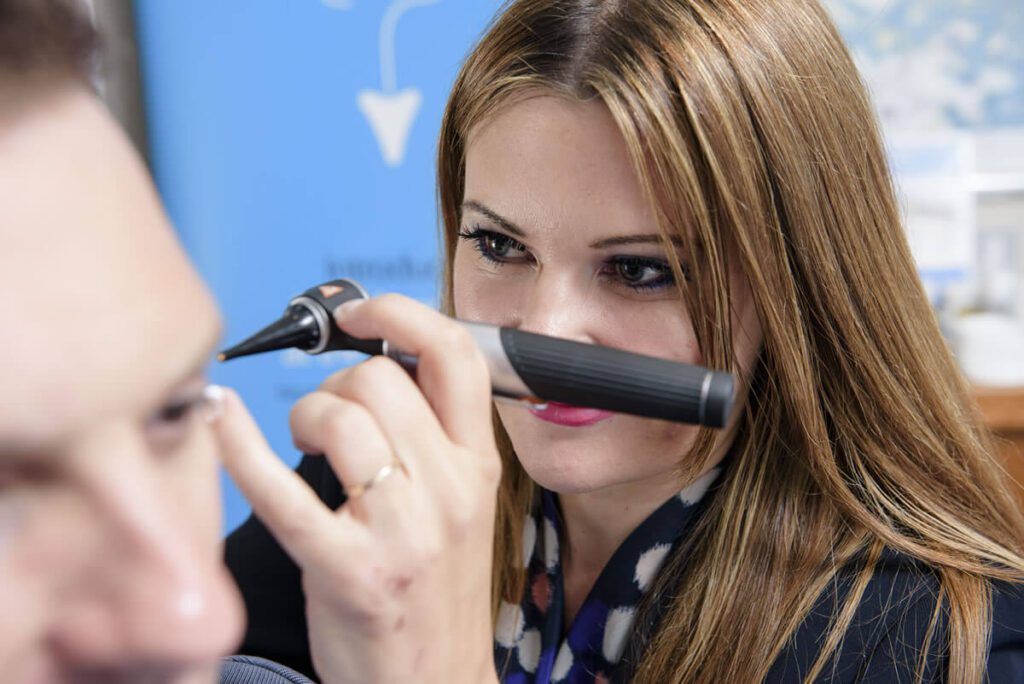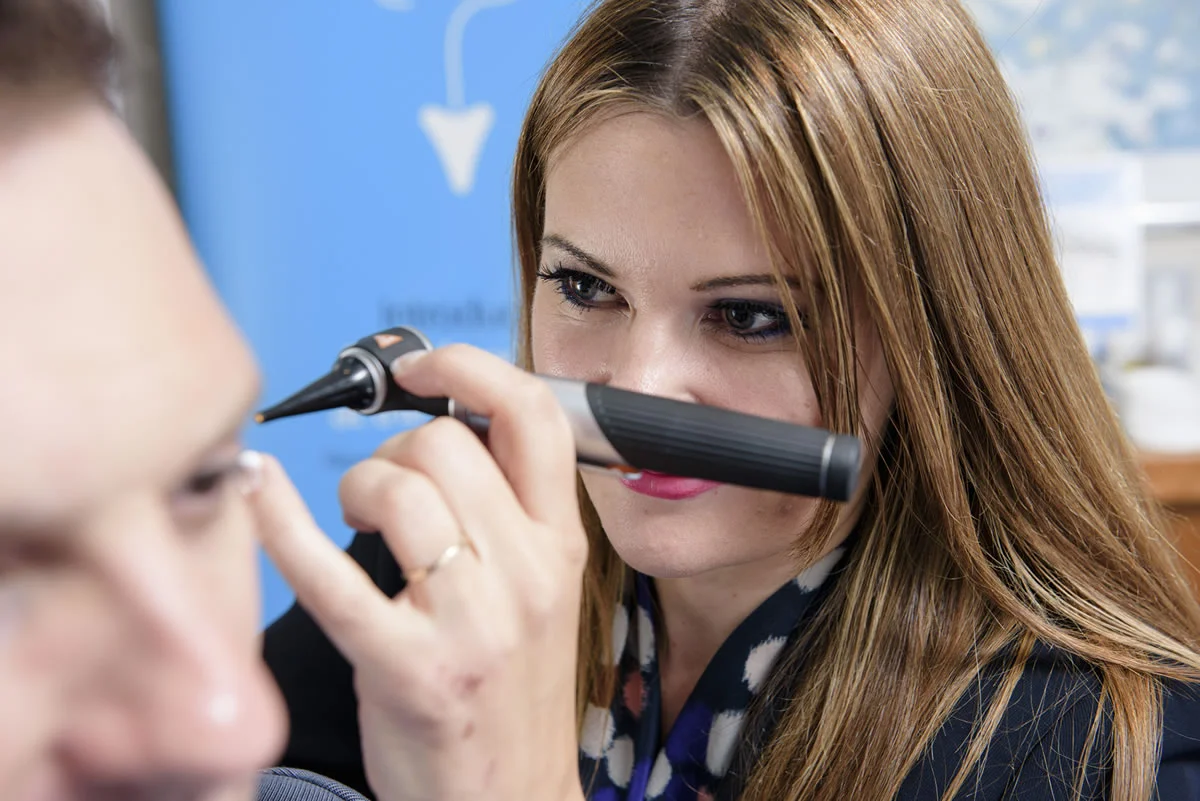Risks associated with syringing to remove a build-up of earwax means an alternative method may be best.
A blockage in the ears caused by a build-up of earwax can impair your hearing and lead to problems like infections, earaches and tinnitus — a ringing or buzzing sound in the ears that doesn’t stop and can be infuriating. So it’s important to have earwax removal done if you’re having trouble with your ears or your hearing.
If there is a buildup of earwax in one or both ears, and perhaps it has become impacted, the usual route at the doctor or hearing specialist is to have your ears syringed. This will remove the blockage, which may have been caused by using cotton buds (now banned in England) or something else to try and clean the ears, but all it did was push the earwax further down the canal, or it might have been caused by wearing earbuds to listen to music or using hearing aids.
Anything you put in your ears, like earbuds and hearing aids, can prevent ear wax from naturally falling out of the ears as it dries and hardens, leaving you with a build-up of earwax that you may need to have removed by a medical or hearing professional. Syringing to clear earwax can have risks, however, so how to remove earwax without syringing? In this post, we will take a deeper look into the trouble earwax can cause and examine an alternative to syringing.
What Is Earwax Anyway?
You might think that earwax is useless and all it does is cause trouble, but you’d be wrong. Cerumen — to give earwax its official name — starts as a fatty substance secreted from glands in the outer part of the ear, and it has several functions that help keep us healthy. One of them is to trap any invaders, like viruses and bacteria, so they don’t work their way further into the body. Another is a moisturising function, keeping the ear canal moist and clean as it moves. People with too little earwax often have itchy ears and may require drops or oil to lubricate them.
Other functions include several chemicals in earwax that can fight infections and the physical fact that earwax protects the delicate structures of the inner ear responsible for hearing, including the eardrum, from the harsh elements in the environment outside the ear. So it turns out there’s a lot of beneficial properties of this sticky and crusty substance you may have thought serves no useful purpose at all.
Through talking or chewing food, the jaw movement helps to propel earwax to the ear opening, where it will harden and fall out. This often happens when you’re lying down, as in sleeping, but, as we’ve mentioned, if something is plugging the opening to the ears, like hearing aids that may be worn all day, earwax won’t be able to fall out. Instead, it will remain in the ear as more earwax is secreted and a build-up occurs.
Signs of a Build-up of Earwax
Too much earwax leads to a number of issues, some of which we’ve mentioned. You may know you have a problem if you experience any of these symptoms:
- Hearing muffled sounds or general difficulty making out speech and noises which may increasingly get worse.
- A feeling that your ear or ears are full.
- Pain and itchiness in the ears.
- Tinnitus — that incessant buzzing and ringing sound we touched on earlier.
- A discharge coming from the ear, which may indicate an infection has taken hold.
- Vertigo or dizziness.
- An unexplained cough.
If you have one or several of these symptoms, make an appointment with your doctor or audiologist to examine your ears. Leaving the problem and hoping it will resolve itself is not advisable, as the symptoms will most likely worsen. You may, for instance, require a course of antibiotics to deal with an infection in the ear.
So How to Remove Earwax without Syringing?
Before we look at how to do ear wax removing without syringing, we need to know what ear syringing is and what the risks are. Having your ears syringed is relatively simple: it involves squirting warm water into the ear canal to dislodge earwax and clean the canal. It’s important that the water is not too cold, or it could result in pain in the ear, or too hot, for the same reason and also that you could feel dizzy too.
Also known as ear irrigation, syringing the ear may have several side effects, the most serious of which is a perforated eardrum due to increased pressure with all the water in the canal. It’s possible that instead of clearing out a build-up of earwax, syringing might make the problem worse, pushing it up against the inner ear and resulting in a worse case of impacted earwax.
Ear syringing can also lead to tinnitus — instead of, again, getting rid of the issue — and dizziness and inflammation or infection can also occur after having your ears syringed. So while it might seem like a simple and harmless procedure, there are real risks to having your ears syringed, and it may be better to choose an alternative method of getting that earwax out of your ears.
The answer lies in a much more gentle procedure called microsuction.
How Is Ear Microsuction Better Than Syringing?
Compared to what may be a tsunami of warm water gushing into your ear canal, with ear syringing, microsuction doesn’t involve water at all and only uses a small sucking action to remove earwax. So there’s no mess with water, it’s completely safe, and there’s no pain or discomfort at all. None of the delicate parts of the ear, including the eardrum, are at risk, and there are no side effects to having the procedure.
You can even have microscution done at home, by a visiting audiologist, like the home visit hearing test Regain Hearing provides to its customers. Microsuction takes about half an hour, and straight away, you’ll notice your hearing has returned to its normal level, and any symptoms like tinnitus may start to disappear, although it might take some time before they fully clear up.
Then you’re back to your old self and hearing the world as you should.
Suspect you have a build-up of ear wax and would like to have microsuction done to clear it? If you need ear wax removal in Broadstairs and Ramsgate all the way South East London and Croydon, Contact Regain Hearing today and make an appointment with our friendly professionals, for a home visit or at one of our clinics.








